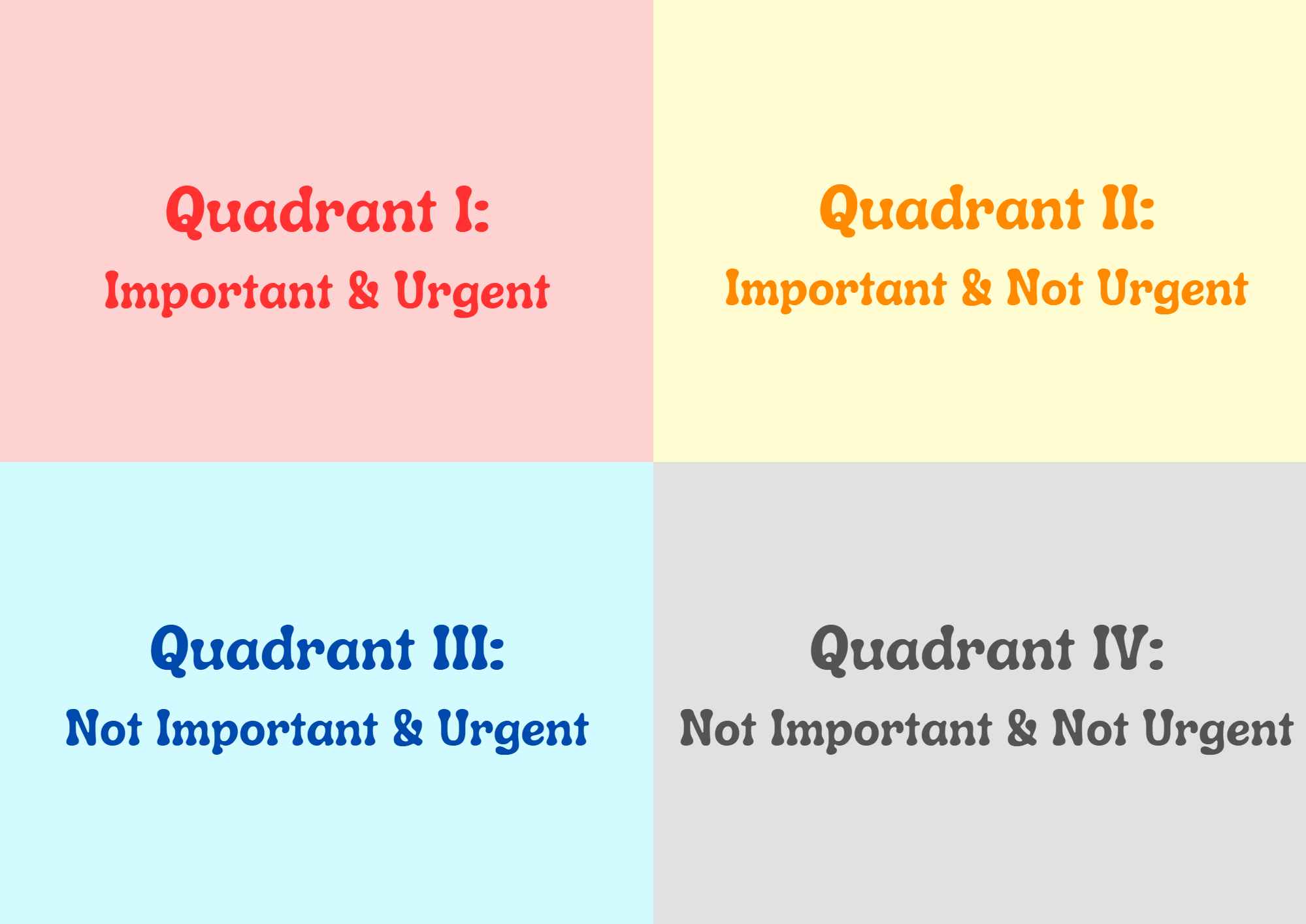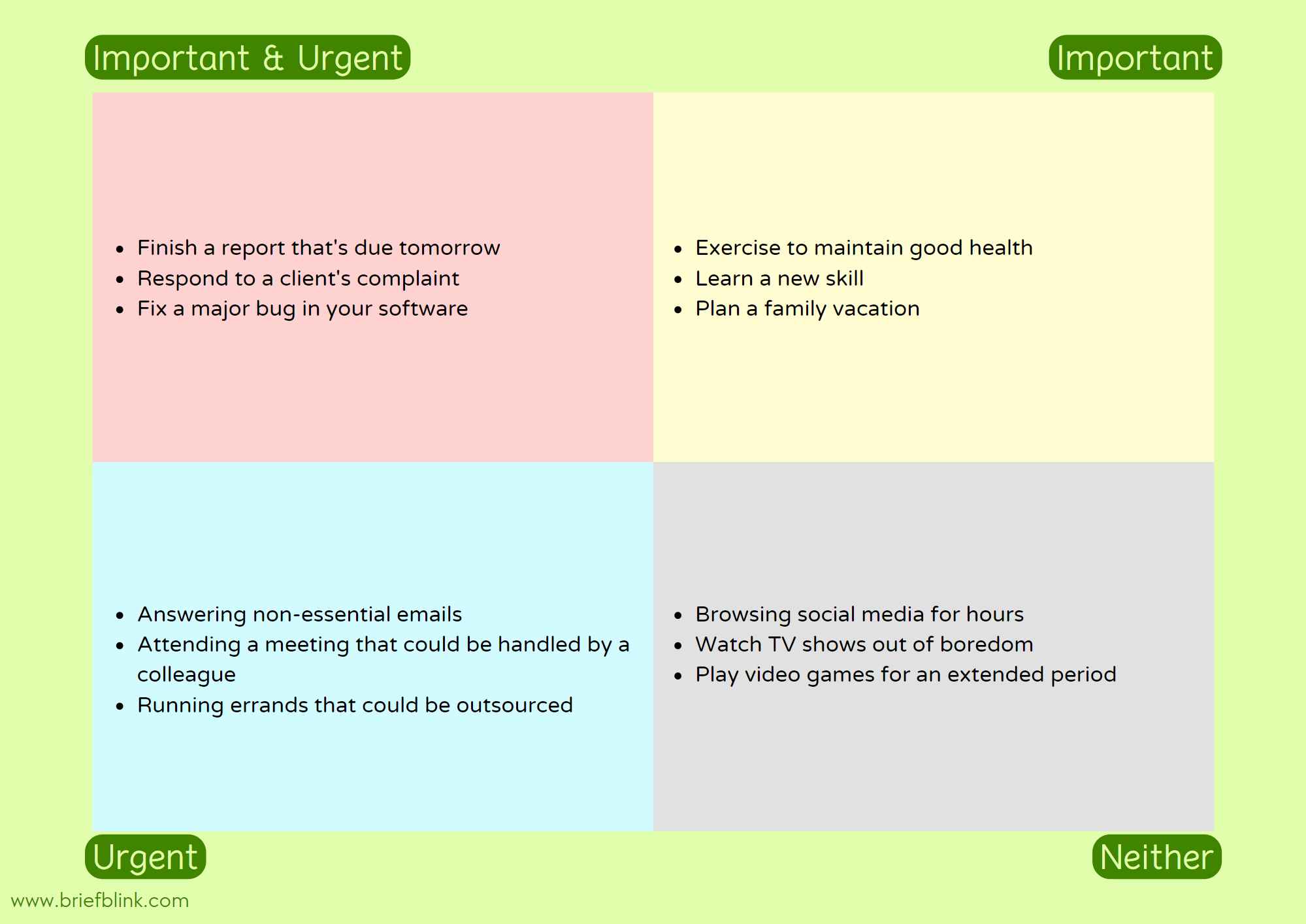Master Time with The Eisenhower Time Management Matrix
Discover the power of the Eisenhower Time Management Matrix. It's a simple yet effective tool for boosting productivity. Learn how to prioritize tasks based on urgency and importance. Transform your workflow for optimal efficiency.

Imagine you're a juggler in a circus. You're balancing several balls in the air. The crowd watches in awe. The spotlight is on you. You can't afford to drop any of the balls. Otherwise, you'll ruin the entire act. That's what it feels like to manage your time in today's fast-paced world.
You have work deadlines, social commitments, family obligations, and personal goals. Everything's competing for your attention. It's easy to feel overwhelmed and drop the ball on something important.
What if I told you that there's a simple yet powerful tool that can help you master your time like a seasoned juggler? That's the Eisenhower Time Management Matrix. It's a framework for organizing your tasks based on their urgency and importance.
By using this matrix, you can prioritize your tasks effectively. You can achieve your goals without feeling like you're constantly juggling too many balls. In this article, we'll explore the principles of the time management matrix and how to use it in your daily life.
What is the Time Management Matrix?
Struggling with time management? The time management matrix might be what you're looking for. It helps you prioritize your tasks. It allows you to focus on what's truly important. You can be more productive and achieve your goals more easily while using it.
Overview and History of the Matrix

President Dwight D. Eisenhower developed this matrix as a tool for work prioritization. It's a structure made up of 4 quadrants of time management. Prioritization and allocation to the quadrants depend on priority and urgency.
Stephen Covey's book The 7 Habits of Highly Effective People later popularised it. Some people refer to this as Covey's matrix.
Importance of Time Management
You may think that time management is just a buzzword. It's actually a key factor in achieving success and living a fulfilling life. Effective time management allows you to:
- Prioritize tasks
- Eliminate time-wasters
- Increase productivity
This is where the time management matrix comes in handy. It's a powerful tool that categorises tasks into four quadrants. The quadrants are based on urgency and importance.
Recognising which tasks are urgent and important helps you proactively deal with them. You'll avoid getting overwhelmed. Identifying which tasks are important but not urgent helps you work towards achieving long-term goals.
You can minimize time spent on unimportant and non-urgent tasks. You can avoid getting bogged down by tasks that aren't meaningful to your personal development. This frees up time for more important tasks.
You can become more productive and efficient, which can lead to a happier and more fulfilling life. In the next section, we'll discuss how the matrix revolutionises time management. You'll see why it's such a powerful tool.
How the Matrix Revolutionises Time Management
The time management matrix helps provide clarity. It's an effective way to improve productivity and achieve goals. It categorises tasks into quadrants and helps prioritize your workload.
Tasks are categorised by importance and urgency. Importance is about whether tasks help us achieve our goals. Urgency is about timeliness. It's about the consequences for not dealing with them on-time.
Let's take a closer look at the four quadrants.
A Closer Look Into the Four Quadrants

The four quadrants are:
- Important and Urgent
- Important but Not Urgent
- Urgent but Not Important
- Not Important and Not Urgent
Understanding each quadrant of the time management matrix is the first step.
Quadrants I and II are where you should spend most of your time and energy. Quadrant III and IV are for unimportant tasks. These are tasks you don't want to spend too much time on.
Quadrant I: Important and Urgent
Quadrant I comprises tasks that require immediate attention. These may be things tasks that appeared out of thin air, like crises. They could also be things you've left until the last minute.
Having too many Quadrant I tasks isn't a good thing. This may happen when you leave too many Quadrant II tasks unchecked. Let's talk about that.
Quadrant II: Important but Not Urgent
Tasks in Quadrant II are still important. They simply don't demand immediate action. This can include planning for the future, building relationships, and developing new skills. Focusing on time-sensitive tasks makes sense. However, don't forget about Quadrant II tasks.
These tasks are often overlooked or delayed. However, they're essential for personal growth and long-term success. By prioritising these tasks, you can ensure that you make time for them. This allows you to prioritize them alongside urgent tasks.
Proper time management is key to balancing the demands of Quadrants I and II.
Quadrant III: Urgent but Not Important
Quadrant III is for the unimportant yet urgent tasks. These are interruptions and distractions. You may be familiar with many of them. It's the ringing phones you have to pick up. It's the emails that beg for your attention.
Don't let these tasks consume you. They distract you from achieving your long-term goals. These tasks only seem pressing. They don't contribute to your overall success. Minimise time spent in this quadrant. Spend your time and energy for things that matter.
Tasks that don't require your skills also fall into this quadrant. Consider delegating these tasks to others. If you're in a team, you may offset your workload and giving someone the chance to develop a skill set.
Quadrant IV: Not Important and Not Urgent
These tasks are unimportant. They're not even time-sensitive. We still get caught up in them. These tasks may seem harmless at first, but they can quickly become major time-wasters. We need to manage them.
You can save time on Quadrant III and IV tasks. How do we do that? Recognise that these tasks don't help you in the long run. Minimise them as much as possible. Batch similar tasks together and complete them all at once.
Let's see how to apply everything so far for better time management.
How to Build a Time Management Matrix
Here's a step-by-step guide to help you use the matrix effectively and boost your productivity. We can break it down to 5 steps:
- List all your tasks
- Set deadlines
- Organise by importance
- Categorise each task
- Plan your time accordingly
Step 1: List All Your Tasks
The first step is to list all your tasks. Grab a pen and a piece of paper. Jot down everything you need to accomplish. This gives you a clear overview of what needs to be done. No task is too big or small to be included in this list. Once you have a comprehensive list, you can move on to the next step.
Step 2: Set Deadlines
It's important to set deadlines for each one. This will help you manage your time more effectively and ensure that you stay on track. Deadlines drive urgency. They motivate you to complete tasks sooner rather than later. Set deadlines to focus on the most urgent tasks.
Step 3: Organise by Importance
It's time to organise them by importance. This step involves determining which tasks are most vital. By doing this, you can map out which tasks matter. You can distinguish between those and tasks that don't matter. You can decide whether you'll delegate less important tasks here.
Step 4: Categorise Each Task
You've determined the time-sensitivity and importance of your tasks. You're ready to categorise each task into one of the four quadrants of the matrix. Ask yourself a few questions about your tasks. These questions may help make it clear how you'll categorise them.
- Is this task important? If yes, your task is within Quadrant I and II.
- Is the task urgent? If yes, this task is within Quadrant II and III.
- Is this task a time-waster? If yes, this task is within Quadrant III and IV.
By categorising your tasks, you can prioritise effectively and focus on what truly matters.
Step 5: Plan Your Time Accordingly
You have a matrix in your hands. It's time to make use of it. The last step is to plan your time accordingly.
Allocate your time to Quadrant 1 tasks first. They require immediate attention. Next, focus on Quadrant 2 tasks. You'll want to prevent them from becoming urgent. Try to batch or delegate Quadrant 3 tasks. Finally, minimise or eliminate Quadrant 4 tasks to avoid wasting time.
Check out this filled out example of the matrix:

The steps seem easy. However, you may have to put in a lot of thought into each of these steps.
Practical Tips for Using the Matrix Effectively
You've just seen how to use the time management matrix. Let's look at how you can make the most of this powerful time management tool.
Review Your Tasks
The time management matrix is dynamic. Regularly review and update your matrix to reflect changes in your tasks and priorities. Give yourself time to be familiar with it. You'll find through practice that it gets easier.
Remember Quadrant 2
It's the important yet non-urgent tasks that we often neglect. These tasks are crucial for you in the long-run. Allocate sufficient time for these tasks. Don't let them become urgent. You might be neglecting tasks like strategic planning, skill development, or relationship building. You shouldn't need a deadline to appreciate the value of these tasks.
Use a Digital Tool
There's nothing wrong with pen and paper. However, digital tools offer ease and flexibility. Many apps and online tools serve this purpose. They can help you create, manage, and update your matrix easily.
These tools can also provide reminders and notifications, which can be helpful for staying on top of your tasks. Here are a few tools that have this functionality:
- Todoist
- TickTick
- ClickUp
- Free Templates (I made one just for you)


You now understand how to use the matrix effectively. Let's look at the benefits and drawbacks of using this tool.
Benefits of the Time Management Matrix
The time management matrix is a powerful tool. Like any tool, it has its strengths and weaknesses. Let's start by exploring some advantages of the time management matrix.
Improved Prioritization
The matrix helps you prioritize your tasks effectively. It allows you to focus on the tasks that will contribute to your long-term goals. This includes your personal life and professional development.
You can clearly see which tasks need your immediate attention and which ones you can schedule. You won't get bogged down by tasks in Quadrant III and IV.
Better Focus on Long-Term Goals
Paying attention to tasks that are important but not urgent (Quadrant II) can be beneficial. They're meaningful, but we often ignore them. The matrix encourages us to look at what's important. It aligns us with our long-term goals and personal growth.
Give these tasks the attention they deserve to make progress towards your goals. You'll also avoid the stress of last-minute rushes.
Less Time Wasters
Cutting out fluff and distractions gets you productive. It fosters a fulfilling life. The time management matrix can help you identify time wasters and minimize them. This can free up time that can be better spent on more valuable tasks.
Let's now consider the limitations.
Limitations of the Time Management Matrix
Difficulty in Categorising Tasks
You can have a lot of tasks to do. You'd have to think hard about where they belong. It's difficult to put them into one of the four categories. It's like trying to sort a pile of mixed-up puzzle pieces.
You may find it hard to decide whether a task is urgent or important. For instance, answering emails may seem like a task that could fall into any quadrant. It depends on its content, sender, and deadline. A meeting may be urgent but not important or vice versa.
Risk of Neglecting Important but Not Urgent Tasks
Don't let the temptation of pressing tasks distract you from the Quadrant II tasks. People often pay more attention to the first quadrant, ignoring the others. This makes the tool almost counter-intuitive.
Oversimplifying Complex Tasks
We're talking about a simplification tool. It may oversimplify complex tasks. Some tasks may not fit neatly into one quadrant. They may span multiple quadrants over time. For instance, a task that starts as important but not urgent (Quadrant 2) can become urgent if it's neglected for too long (Quadrant I).
We have to remind ourselves that we're taking a snapshot of our priorities. Regularly review your matrix to keep it in check.
Conclusion
Congratulations! You've now learned the key principles of the Eisenhower time management matrix. You should be able to use it effectively. By prioritizing tasks based on their urgency and importance, you can take control of your time and increase your productivity.
By implementing the time management matrix, you can take the first step toward better time management and a more balanced life. Remember to regularly review and update your tasks to ensure you're focusing on what truly matters.
With practice, you can become a master of your time and achieve your goals with greater ease and efficiency. To get you started, download this pdf file for free. You might not squeeze all your tasks in there, but this will help you visualise your matrix.
Frequently Asked Questions
How does the time management matrix compare to other time management tools?
The matrix stands out because it's simple and effective. It helps you distinguish between urgent and important tasks. It's designed to improve productivity by teaching you how to prioritize better. Unlike some other tools, it's not only about getting tasks done. Rather, it's about doing the right tasks at the right time.
Can the time management matrix be used for personal tasks or is it mainly for work-related tasks?
Yes, you can use the matrix for both personal and work-related tasks. It works with tasks from all aspects of life. It's fairly versatile. You could plan your day-to-day tasks. You could handle large projects. The matrix can help you prioritize most things effectively.
Should you use a time tracking tool alongside the time management matrix for optimal results?
A time tracking tool isn't necessary. However, using a time tracking tool alongside it can enhance your productivity. It can help monitor progress and identify areas for improvement.
You can gain insight on how much time you're spending, or wasting. You can better understand your work patterns. Time tracking lets you understand gaps in your schedule. It allows you to further optimise your time management.
How can we adapt the time management matrix for team or collaborative work?
Adapting the time management matrix for the team-setting can greatly enhance productivity. Repeat the same process of listing tasks to categorising them. This will be a share matrix.
Assign tasks to team members based on their skills and availability. Regularly review and update the matrix as a team. Everyone has to stay on the same page. This ensures that tasks are being completed efficiently.
What are the common mistakes people make when using the time management matrix, and how can they be avoided?
One common mistake is not categorising tasks accurately. You can avoid this by properly assessing the urgency and importance of each task. Take the time to think about each task. Carefully evaluate their relevance to your long-term goals.

